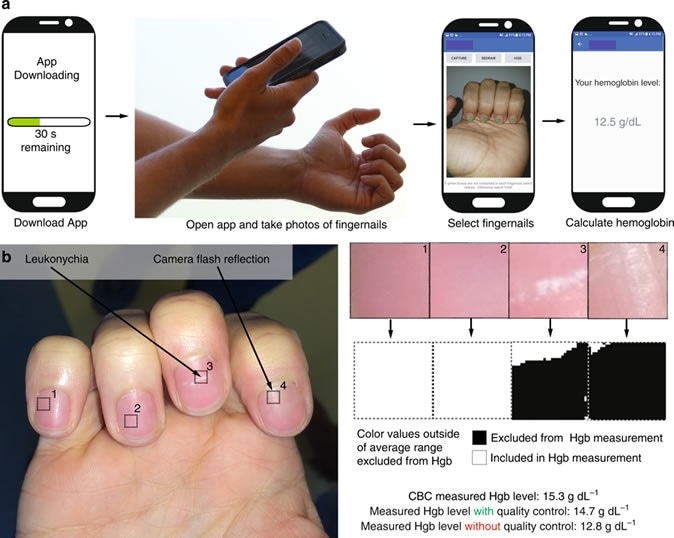Researchers from the Emory University have developed a new phone app that needs just a colour photograph of the nail beds of an individual to detect anemia in them. The results of the report titled, “Smartphone app for non-invasive detection of anemia using only patient-sourced photos,” were published in the latest issue of the journal Nature Communications.

Implementation of a smartphone app for measuring hemoglobin (Hgb). a A patient simply downloads the app onto their smartphone, opens the app, obtains a smartphone photo of his/her fingernail beds, and without the need for any blood sampling or additional smartphone attachments or external calibration tools, quantitatively measures blood Hgb levels. The patient first takes an image of their fingernails, and is then prompted by the app to tap on the screen to select the regions of interest corresponding to the nailbeds, and a result is then displayed on the smartphone screen. Images are screenshots and photos of actual operation of this app. b As smartphone images with fingernail irregularities such as camera flash reflections or leukonychia may affect Hgb level measurements, a quality control algorithm integrated within the Hgb level measurement app detects and omits those irregularities to preserve measurement integrity and accuracy. Image Credit: Nature Communications
Anemia results from reduced amounts of iron and haemoglobin blood or reduced oxygen carrying capacity of blood. It can result in features ranging from pallor to weakness, shortness of breath, fatigue and even heart failure in severe cases. Statistics have shown that around 3 million people living in America are diagnosed with anemia annually. These individuals may get anemia due to dietary insufficiencies or other causes. They need regular blood tests to check on their haemoglobin levels. Being anemic also raises the risk of several diseases and conditions.
The new app developed by the scientists can detect levels of haemoglobin and red blood cell counts by looking at the colour of the nail beds from the pictures. This test can be performed without the hassle of painful blood tests, the team explains. The test was originally developed by an engineering PhD student Rob Mannino, at the Emory University, Atlanta, was himself was suffering from a genetic blood disorder named beta thalassemia, that caused anemia in him. He would normally require routine blood tests to detect levels of anemia and when his anemia was bad he would require blood transfusions.
Mannino explained that due to regular blood transfusions he would often get an overload of iron in his body which would cause other problems. The doctors needed to test his haemoglobin levels, he explained, before he could be scheduled for a transfusion. He said that these tests were becoming routine and a hassle. To rid of this, Mannino associated with fellow biomedical engineer at the University, Dr Wilbur Lam to develop this test.
Mannino tested the app on himself by regularly photographing his nail beds and using the app to determine the fluctuating levels of haemoglobin in his blood. The researchers explained that the colour of the fingernails can help determine the levels of red blood cells because of the absence of melanin there. Thus there is no influence of skin tone or tan over the skin underneath the nails and the skin can clearly show the red blood cell concentration.
Dr. Lam explained that Mannino’s pictures of his nail beds “enabled him to constantly refine and tweak his technology on himself in a very efficient manner. So essentially, he was his own perfect initial test subject with each iteration of the app.” The app was then tested on four individuals who had haemoglobin deficiencies and different skin tones. Each time the app was successful in determining the levels of red blood cells. The team then went on to photograph the nail beds of 227 people with or without anemia and the test was successful. The test was then conducted on 100 people more to perfect an algorithm. They developed their app based on the algorithm on the results of the four individuals. Lam explained, “This is just a snapshot of the accuracy right now. The algorithm gets smarter with every patient enrolled.”
Researchers have warned that this test can only provide a guide to the haemoglobin levels and the results are far from accurate. The app can just predict the risk of anemia in individuals they explain. Lam counted off the benefits of the app saying, “All other "point-of-care" anemia detection tools require external equipment, and represent trade-offs between invasiveness, cost, and accuracy. This is a standalone app whose accuracy is on par with currently available point-of-care tests without the need to draw blood.”
Researchers and experts have lauded this new app saying that it could help women who are menstruating or those who are pregnant because they are at a greater risk of anemia.
The research work was sponsored by the National Science Foundation, the 2017 Massachusetts General Hospital Primary Care Technology Prize, and the National Institutes of Health (NIH).